Fibrinogen gamma chain
| FGG | |||||||||||||||||||||||||||||||||||||||||||||||||||
|---|---|---|---|---|---|---|---|---|---|---|---|---|---|---|---|---|---|---|---|---|---|---|---|---|---|---|---|---|---|---|---|---|---|---|---|---|---|---|---|---|---|---|---|---|---|---|---|---|---|---|---|
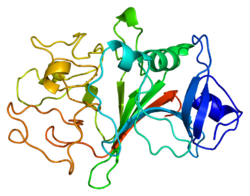 | |||||||||||||||||||||||||||||||||||||||||||||||||||
| |||||||||||||||||||||||||||||||||||||||||||||||||||
| Identifiers | |||||||||||||||||||||||||||||||||||||||||||||||||||
| Aliases | FGG, fibrinogen gamma chain | ||||||||||||||||||||||||||||||||||||||||||||||||||
| External IDs | OMIM: 134850; MGI: 95526; HomoloGene: 429; GeneCards: FGG; OMA:FGG - orthologs | ||||||||||||||||||||||||||||||||||||||||||||||||||
| |||||||||||||||||||||||||||||||||||||||||||||||||||
| |||||||||||||||||||||||||||||||||||||||||||||||||||
| |||||||||||||||||||||||||||||||||||||||||||||||||||
| |||||||||||||||||||||||||||||||||||||||||||||||||||
| |||||||||||||||||||||||||||||||||||||||||||||||||||
| Wikidata | |||||||||||||||||||||||||||||||||||||||||||||||||||
| |||||||||||||||||||||||||||||||||||||||||||||||||||
Fibrinogen gamma chain, also known as fibrinogen gamma gene (FGG), is a human gene found on chromosome 3.[5]
The protein encoded by this gene is the gamma component of fibrinogen, a blood-borne glycoprotein composed of three pairs of nonidentical polypeptide chains. Following vascular injury, fibrinogen is cleaved by thrombin to form fibrin which is the most abundant component of blood clots. In addition, various cleavage products of fibrinogen and fibrin regulate cell adhesion and spreading, display vasoconstrictor and chemotactic activities, and are mitogens for several cell types. Mutations in this gene lead to several disorders, including dysfibrinogenemia, hypofibrinogenemia and thrombophilia.[6] Alternative splicing of the mRNA chain results in two transcript variants; the common γA chain and the alternatively spliced γ' chain. Approximately 10% of the total plasma fibrinogen consists of γA/γ' fibrinogen, with <1% consisting of γ'/γ' fibrinogen. Increased and decreased levels of γA/γ' fibrinogen have been associated with coronary artery disease and deep vein thrombosis respectively. In the lung parenchyma of smokers, upregulation of FGG transcript levels has been reported. [7]
References
- ^ a b c GRCh38: Ensembl release 89: ENSG00000171557 – Ensembl, May 2017
- ^ a b c GRCm38: Ensembl release 89: ENSMUSG00000033860 – Ensembl, May 2017
- ^ "Human PubMed Reference:". National Center for Biotechnology Information, U.S. National Library of Medicine.
- ^ "Mouse PubMed Reference:". National Center for Biotechnology Information, U.S. National Library of Medicine.
- ^ Emeis J (2007). "A guide to murine coagulation factor structure, function, assays, and genetic alterations". Journal of Thrombosis and Haemostasis. 5 (4): 670–679. doi:10.1111/j.1538-7836.2007.02408.x. PMID 17403201.
- ^ "Entrez Gene: FGG fibrinogen gamma chain".
- ^ Pintarelli G, Noci S, Maspero D, Pettinicchio A, Dugo M, De Cecco L, Incarbone M, Tosi D, Santambrogio L, Dragani TA, Colombo F (September 2019). "Cigarette smoke alters the transcriptome of non-involved lung tissue in lung adenocarcinoma patients". Scientific Reports. 9 (1): 13039. Bibcode:2019NatSR...913039P. doi:10.1038/s41598-019-49648-2. PMC 6736939. PMID 31506599.
Further reading
- Doolittle RF (1984). "Fibrinogen and fibrin". Annu. Rev. Biochem. 53: 195–229. doi:10.1146/annurev.bi.53.070184.001211. PMID 6383194.
- Herrick S, Blanc-Brude O, Gray A, Laurent G (1999). "Fibrinogen". Int. J. Biochem. Cell Biol. 31 (7): 741–6. doi:10.1016/S1357-2725(99)00032-1. PMID 10467729.
- Everse SJ (2003). "New insights into fibrin (ogen) structure and function". Vox Sang. 83 (Suppl 1): 375–82. doi:10.1111/j.1423-0410.2002.tb05338.x. PMID 12617173. S2CID 21813767.
- Mosesson MW (2003). "Fibrinogen gamma chain functions". J. Thromb. Haemost. 1 (2): 231–8. doi:10.1046/j.1538-7836.2003.00063.x. PMID 12871494. S2CID 40708829.
- Scott EM, Ariëns RA, Grant PJ (2005). "Genetic and environmental determinants of fibrin structure and function: relevance to clinical disease". Arterioscler. Thromb. Vasc. Biol. 24 (9): 1558–66. doi:10.1161/01.ATV.0000136649.83297.bf. PMID 15217804. S2CID 21298700.
- v
- t
- e
-
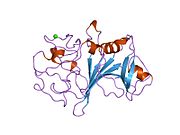 1fib: RECOMBINANT HUMAN GAMMA-FIBRINOGEN CARBOXYL TERMINAL FRAGMENT (RESIDUES 143-411) BOUND TO CALCIUM AT PH 6.0
1fib: RECOMBINANT HUMAN GAMMA-FIBRINOGEN CARBOXYL TERMINAL FRAGMENT (RESIDUES 143-411) BOUND TO CALCIUM AT PH 6.0 -
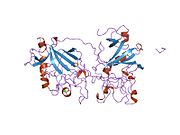 1fic: STRUCTURE OF HUMAN GAMMA FIBRINOGEN 30 KD CARBOXYL TERMINAL FRAGMENT
1fic: STRUCTURE OF HUMAN GAMMA FIBRINOGEN 30 KD CARBOXYL TERMINAL FRAGMENT -
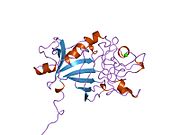 1fid: STRUCTURE OF HUMAN GAMMA FIBRINOGEN 30 KD CARBOXYL TERMINAL FRAGMENT
1fid: STRUCTURE OF HUMAN GAMMA FIBRINOGEN 30 KD CARBOXYL TERMINAL FRAGMENT -
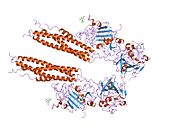 1fza: CRYSTAL STRUCTURE OF FIBRINOGEN FRAGMENT D
1fza: CRYSTAL STRUCTURE OF FIBRINOGEN FRAGMENT D -
 1fzb: CRYSTAL STRUCTURE OF CROSSLINKED FRAGMENT D
1fzb: CRYSTAL STRUCTURE OF CROSSLINKED FRAGMENT D -
 1fzc: CRYSTAL STRUCTURE OF FRAGMENT DOUBLE-D FROM HUMAN FIBRIN WITH TWO DIFFERENT BOUND LIGANDS
1fzc: CRYSTAL STRUCTURE OF FRAGMENT DOUBLE-D FROM HUMAN FIBRIN WITH TWO DIFFERENT BOUND LIGANDS -
 1fze: CRYSTAL STRUCTURE OF FRAGMENT DOUBLE-D FROM HUMAN FIBRIN
1fze: CRYSTAL STRUCTURE OF FRAGMENT DOUBLE-D FROM HUMAN FIBRIN -
 1fzf: CRYSTAL STRUCTURE OF FRAGMENT DOUBLE-D FROM HUMAN FIBRIN WITH THE PEPTIDE LIGAND GLY-HIS-ARG-PRO-AMIDE
1fzf: CRYSTAL STRUCTURE OF FRAGMENT DOUBLE-D FROM HUMAN FIBRIN WITH THE PEPTIDE LIGAND GLY-HIS-ARG-PRO-AMIDE -
 1fzg: CRYSTAL STRUCTURE OF FRAGMENT D FROM HUMAN FIBRINOGEN WITH THE PEPTIDE LIGAND GLY-HIS-ARG-PRO-AMIDE
1fzg: CRYSTAL STRUCTURE OF FRAGMENT D FROM HUMAN FIBRINOGEN WITH THE PEPTIDE LIGAND GLY-HIS-ARG-PRO-AMIDE -
 1lt9: Crystal Structure of Recombinant Human Fibrinogen Fragment D
1lt9: Crystal Structure of Recombinant Human Fibrinogen Fragment D -
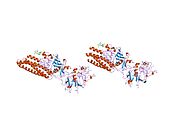 1ltj: Crystal Structure of Recombinant Human Fibrinogen Fragment D with the Peptide Ligands Gly-Pro-Arg-Pro-Amide and Gly-His-Arg-Pro-Amide
1ltj: Crystal Structure of Recombinant Human Fibrinogen Fragment D with the Peptide Ligands Gly-Pro-Arg-Pro-Amide and Gly-His-Arg-Pro-Amide -
 1n86: Crystal structure of human D-dimer from cross-linked fibrin complexed with GPR and GHRPLDK peptide ligands.
1n86: Crystal structure of human D-dimer from cross-linked fibrin complexed with GPR and GHRPLDK peptide ligands. -
 1n8e: Fragment Double-D from Human Fibrin
1n8e: Fragment Double-D from Human Fibrin -
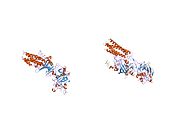 1re3: Crystal Structure of Fragment D of BbetaD398A Fibrinogen with the Peptide Ligand Gly-His-Arg-Pro-Amide
1re3: Crystal Structure of Fragment D of BbetaD398A Fibrinogen with the Peptide Ligand Gly-His-Arg-Pro-Amide -
 1re4: Crystal Structure of Fragment D of BbetaD398A Fibrinogen
1re4: Crystal Structure of Fragment D of BbetaD398A Fibrinogen -
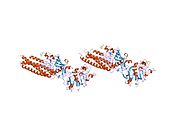 1rf0: Crystal Structure of Fragment D of gammaE132A Fibrinogen
1rf0: Crystal Structure of Fragment D of gammaE132A Fibrinogen -
 1rf1: Crystal Structure of Fragment D of gammaE132A Fibrinogen with the Peptide Ligand Gly-His-Arg-Pro-amide
1rf1: Crystal Structure of Fragment D of gammaE132A Fibrinogen with the Peptide Ligand Gly-His-Arg-Pro-amide -
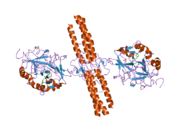 2a45: Crystal structure of the complex between thrombin and the central ""E"" region of fibrin
2a45: Crystal structure of the complex between thrombin and the central ""E"" region of fibrin -
 2ffd: Fibrinogen Fragment D with ""A"" knob peptide mimic GPRVVE
2ffd: Fibrinogen Fragment D with ""A"" knob peptide mimic GPRVVE -
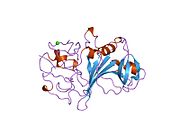 2fib: RECOMBINANT HUMAN GAMMA-FIBRINOGEN CARBOXYL TERMINAL FRAGMENT (RESIDUES 143-411) COMPLEXED TO THE PEPTIDE GLY-PRO-ARG-PRO AT PH 6.0
2fib: RECOMBINANT HUMAN GAMMA-FIBRINOGEN CARBOXYL TERMINAL FRAGMENT (RESIDUES 143-411) COMPLEXED TO THE PEPTIDE GLY-PRO-ARG-PRO AT PH 6.0 -
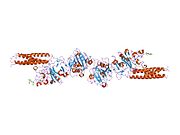 2h43: Crystal Structure of Human Fragment D Complexed with Ala-His-Arg-Pro-amide
2h43: Crystal Structure of Human Fragment D Complexed with Ala-His-Arg-Pro-amide -
 2hod: Crystal Structure of Fragment D from Human Fibrinogen Complexed with Gly-hydroxyPro-Arg-Pro-amide
2hod: Crystal Structure of Fragment D from Human Fibrinogen Complexed with Gly-hydroxyPro-Arg-Pro-amide -
 2hpc: Crystal structure of fragment D from Human Fibrinogen Complexed with Gly-Pro-Arg-Pro-amide.
2hpc: Crystal structure of fragment D from Human Fibrinogen Complexed with Gly-Pro-Arg-Pro-amide. -
 2oyh: Crystal Structure of Fragment D of gammaD298,301A Fibrinogen with the Peptide Ligand Gly-His-Arg-Pro-Amide
2oyh: Crystal Structure of Fragment D of gammaD298,301A Fibrinogen with the Peptide Ligand Gly-His-Arg-Pro-Amide -
 2oyi: Crystal Structure of Fragment D of gammaD298,301A Fibrinogen with the Peptide Ligand Gly-Pro-Arg-Pro-Amide
2oyi: Crystal Structure of Fragment D of gammaD298,301A Fibrinogen with the Peptide Ligand Gly-Pro-Arg-Pro-Amide -
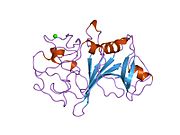 3fib: RECOMBINANT HUMAN GAMMA-FIBRINOGEN CARBOXYL TERMINAL FRAGMENT (RESIDUES 143-411) BOUND TO CALCIUM AT PH 6.0: A FURTHER REFINEMENT OF PDB ENTRY 1FIB, AND DIFFERS FROM 1FIB BY THE MODELLING OF A CIS PEPTIDE BOND BETWEEN RESIDUES K338 AND C339
3fib: RECOMBINANT HUMAN GAMMA-FIBRINOGEN CARBOXYL TERMINAL FRAGMENT (RESIDUES 143-411) BOUND TO CALCIUM AT PH 6.0: A FURTHER REFINEMENT OF PDB ENTRY 1FIB, AND DIFFERS FROM 1FIB BY THE MODELLING OF A CIS PEPTIDE BOND BETWEEN RESIDUES K338 AND C339
 | This article on a gene on human chromosome 4 is a stub. You can help Wikipedia by expanding it. |
- v
- t
- e











































